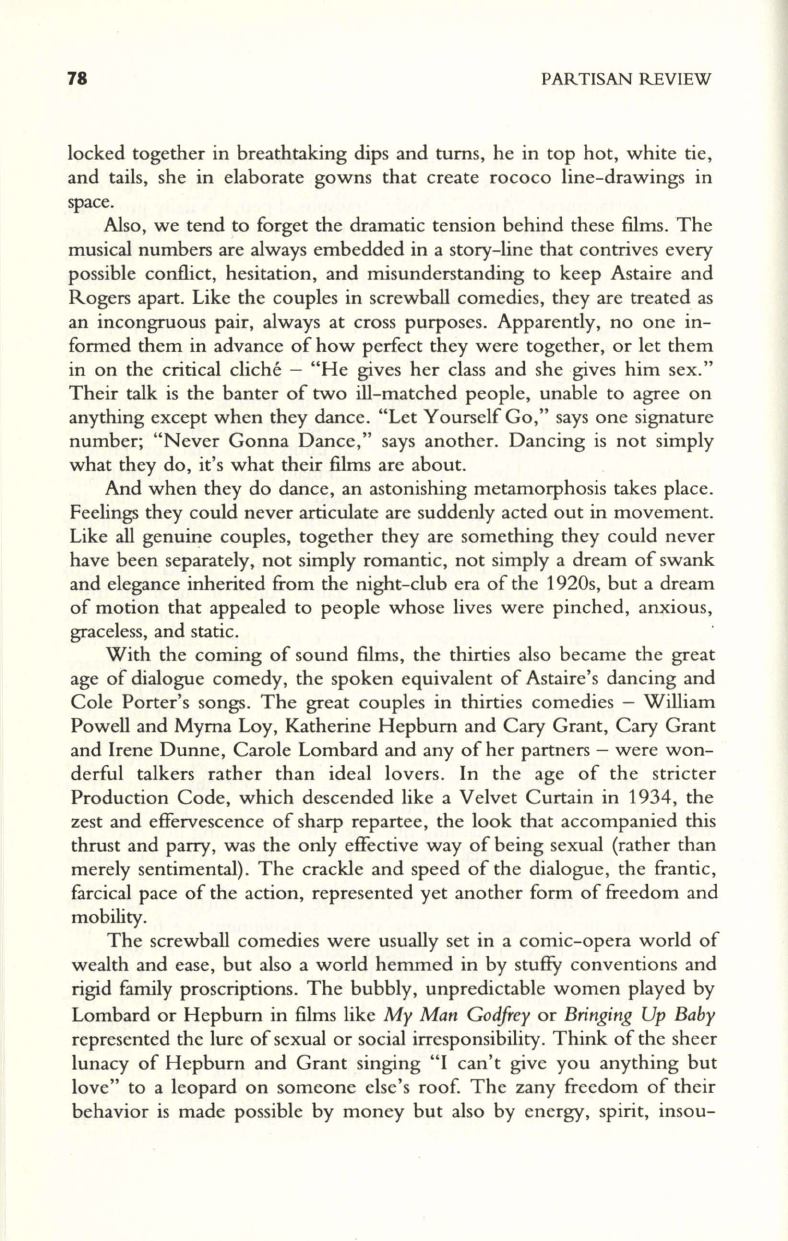
78
PARTISAN REVIEW
locked together in breathtaking dips and turns, he in top hot, white tie,
and tails, she in elaborate gowns that create rococo line-drawings in
space.
Also, we tend to forget the dramatic tension behind these films. The
musical numbers are always embedded in a story-line that contrives every
possible conflict, hesitation, and misunderstanding to keep Astaire and
Rogers apart. Like the couples in screwball comedies, they are treated as
an incongruous pair, always at cross purposes. Apparently, no one in–
formed them in advance of how perfect they were together, or let them
in on the critical cliche - "He gives her class and she gives him sex."
Their talk is the banter of two ill-matched people, unable to agree on
anything except when they dance. "Let Yourself Go," says one signature
number; "Never Gonna Dance," says another. Dancing is not simply
what they do, it's what their films are about.
And when they do dance, an astonishing metamorphosis takes place.
Feelings they could never articulate are suddenly acted out in movement.
Like all genuine couples, together they are something they could never
have been separately, not simply romantic, not simply a dream of swank
and elegance inherited from the night-club era of the 1920s, but a dream
of motion that appealed to people whose lives were pinched, anxious,
graceless, and static.
With the coming of sound films, the thirties also became the great
age of dialogue comedy, the spoken equivalent of Astaire's dancing and
Cole Porter's songs. The great couples in thirties comedies - William
Powell and Myrna Loy, Katherine Hepburn and Cary Grant, Cary Grant
and Irene Dunne, Carole Lombard and any of her partners - were won–
derful talkers rather than ideal lovers.
In
the age of the stricter
Production Code, which descended like a Velvet Curtain in 1934, the
zest and effervescence of sharp repartee, the look that accompanied this
thrust and parry, was the only effective way of being sexual (rather than
merely sentimental). The crackle and speed of the dialogue, the frantic,
farcical pace of the action, represented yet another form of freedom and
mobility.
The screwball comedies were usually set in a comic-opera world of
wealth and ease, but also a world hemmed in by stuffy conventions and
rigid family proscriptions. The bubbly, unpredictable women played by
Lombard or Hepburn in films like
My
Man Godfrey
or
Bringing Up Baby
represented the lure of sexual or social irresponsibility. Think of the sheer
lunacy of Hepburn and Grant singing "I can't give you anything but
love" to a leopard on someone else's roo( The zany freedom of their
behavior is made possible by money but also by energy, spirit, insou-


